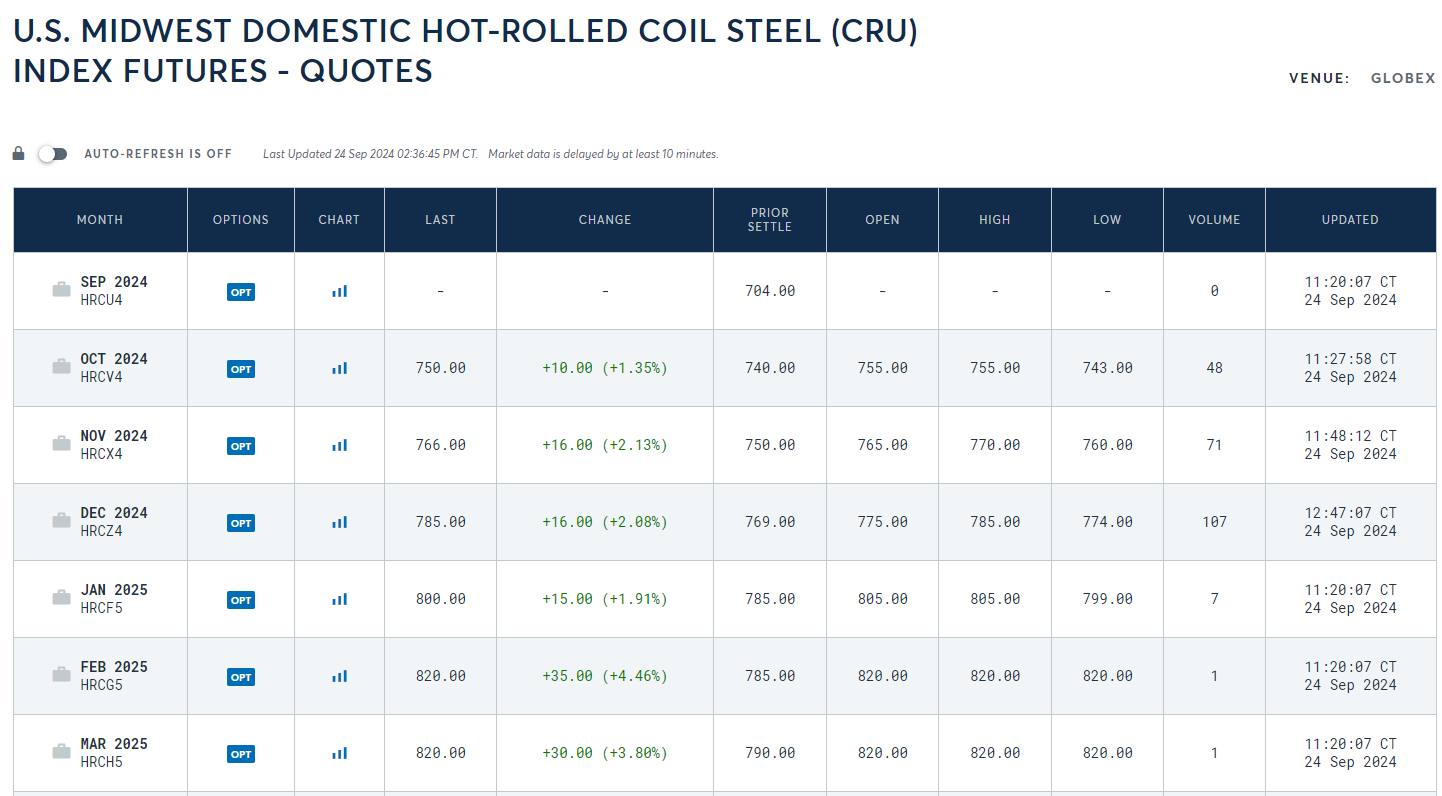Analysis
September 24, 2024
Final thoughts
Written by Michael Cowden
SMU’s price ranges for flat-rolled steel were mostly sideways on Tuesday even as futures market shot higher.
I received some questions as to why hot-rolled (HR) coil futures shot higher. As best as I can tell, it might have been in response to news that China plans to roll out stimulus measures. We have details on those measures here thanks to our colleagues at CRU.

I thought that was a bit of a head-scratcher. The need for stimulus typically indicates that things aren’t going so well. China does not ship much in the way of finished steel into the US because of existing duties and tariffs.
Whatever the case, as I noted in my last Final thoughts, there is plenty of reason to be bullish on US sheet prices in Q4 and into Q1 of next year.
There is a major trade case against coated products pending. We could see increased trade restrictions against Mexico. And we could also see a major strike at US ports as soon as next week. Combine that with planned fall maintenance outages, and you could make a strong case that US mills should be able to continue ride the current “mini-rally” higher.
There are some big questions of course. What kind of trade restrictions on Mexico are we talking about exactly? A group of US senators has floated a 25% tariff on imports of Mexican steel. Former President Donald Trump is threatening a 200% tariff on John Deere, a US company, should it move production to Mexico. And the Biden administration has already announced stricter Section 232 measures against Mexico. (Less talked about: What if Mexico – or Canada, which is also targeted in the coated trade case – retaliates?)
As Lewis Leibowitz noted in a column on Sunday, the data don’t necessarily support such moves against Mexico. But numbers have a way of not getting in the way of a narrative, especially in an election year. Just ask U.S. Steel and Nippon Steel what happens to logic and moderation when an issue becomes a political football and the White House is up for grabs.
And yet for every person that tells me potential trade restrictions are already having an impact and that steel prices have nowhere to go but up, another says that it’s too early to say.
Some note that we could see – somewhat counterintuitively – more coated imports toward the end of the year. Basically, recently placed orders or shipments already on the water coming in. Perhaps driven by folks trying to get in a last cargo before Commerce publishes preliminary duty margins. (SMU has a helpful timeline for the trade case here.)
Certainly, the widely anticipated case had no impact on August import licenses. The US was licensed to import approximately 403,000 short tons (366,000 metric tons) of coated flat-rolled steel in August, up 11% from 362,000 short tons in July, according to Commerce Department figures.
And I’ve been told by some of you that other nations not targeted in the case – Indonesia and Pakistan, for example – could help fill some of the gaps left by Vietnam, arguably the primary target of the case. Keep in mind, too, that all the tons that Vietnam had been sending to the US will have to find a home elsewhere. Where will that be?
And on the HR side, even as more and more mills press for $700-750 per short ton (st), some of you tell me that prices in the $600s are still readily available from other producers. You might also note that certain mills have lengthy secondary and excess prime lists. And that those prices haven’t budged much even as spot prices for prime material have steadily risen.
Maybe that shouldn’t be a surprise. Automotive looks like it’s slowing down. There are planned layoffs at Stellantis, according to the Detroit Free-Press. General Motors also has major layoffs slated, according to Automotive News. Meanwhile, dealer inventories are higher than they were a year ago, according to Cox Automotive. Heck, who can even afford a new car anymore, especially once you factor in gas and insurance? (Um, asking for a friend.)
As I’ve noted before, our survey data indicates that service center inventories are high and demand is weaker than it was a year ago. Yes, HR lead times are nearly five weeks on average for HR, which is a healthy number. Will they remain so once we’re past most fall maintenance outages about 30-45 days from now?
But back to the futures. One thing that strikes me is how steady prices have been over the last three months. Especially by the standards of the last three years. That’s why the big moves upward caught my attention.
Steel is infamously volatile. Can we really continue to tread water around $650-750/st? Or will we see prices break out above that level or fall below it? Maybe it’s just too hard to know, which is why some of you tell me that you’re still in “wait-and-see mode.”







